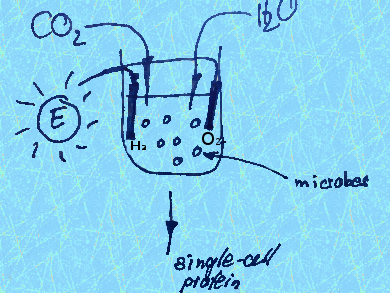Jero Ahola, Lappeenranta University of Technology (LUT), Finland, Juha-Pekka Pitkänen, VTT Technical Research Centre of Finland, Espoo, Finland, and colleagues have developed a method to produce a batch of single-celled protein using electricity and carbon dioxide. As stated in the press release, the method shows potential for use as food and animal feed. According to the researchers, water, CO2, and microbes are exposed in a bioreactor to electrolysis. A powder is formed which contains more than 50 % protein and 25 % carbohydrates. The texture can be changed by altering the microbes.
According to estimates by the researchers, the process of creating food from electricity can be nearly ten times as energy-efficient as common photosynthesis. The method does not require a location with the conditions for agriculture, such as the right temperature, humidity, or a certain soil type and it does not require pest-control substances.
Currently, production of 1 g of protein in a bioreactor of the size of a cup takes around two weeks. So, the production process must become more efficient. The researcher’s goal is a container-sized facility that can produce 5 kg of single-celled protein in a day. They hope to reach this in another 2 – 3 years. According to the researchers, then they could scale up by just constructing more containers and increasing the size of the reactors. Ten years might be a realistic timeframe for reaching commercial capacity, in terms of the necessary legislation and process technology.
The study is part of the Neo-Carbon Energy research project in Finland that aims to develop a completely renewable and emission-free energy system.
- Finnish breakthrough: Making protein out of thin air and electricity,
Yle 22.7.2017 - Neo-Carbon Energy




